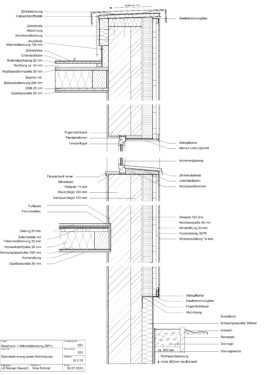
Building Physics I
3rd Semester
Winter Semester 2022/2023
Interior Architecture B.A. | Building Physics and Thermal Insulation
Supervision: LB Manuel Oswald
Burg Giebichenstein University of Art and Design Halle
A residential building from 1890 was renovated for energy efficiency. Due to heritage protection, the street-facing façade remained unchanged, while the freestanding gable wall was insulated. The goal was to develop an insulation concept that met the requirements of the Building Energy Act (GEG 2020), particularly a maximum U-value of 0.24 W/(m²K) for the external wall. The historical construction (e.g., timber beam ceilings, parquet flooring, stucco) and the technical specifications of the existing wall were taken into account. Various insulation materials were compared regarding their advantages and disadvantages, and a suitable insulation type was selected.
Seaweed was chosen as the insulation material. It can be seen as a renewable, natural raw material that is considered a waste product in nature. This means that very little primary energy is used. With its very good heat storage capacity, it is also in the good middle range in terms of thermal conductivity.
Thanks to its diffusion openness, it is insensitive to moisture. In addition, the high salt content serves as a natural fire protection and prevents mold and rodents from causing structural damage. Disposal is safe and sustainable, as it is a natural product and can be returned to the natural cycle at any time.
Building Physics I
3rd Semester
Winter Semester 2022/2023
Interior Architecture B.A. | Building Physics and Thermal Insulation
Supervision: LB Manuel Oswald
Burg Giebichenstein University of Art and Design Halle
A residential building from 1890 was renovated for energy efficiency. Due to heritage protection, the street-facing façade remained unchanged, while the freestanding gable wall was insulated. The goal was to develop an insulation concept that met the requirements of the Building Energy Act (GEG 2020), particularly a maximum U-value of 0.24 W/(m²K) for the external wall. The historical construction (e.g., timber beam ceilings, parquet flooring, stucco) and the technical specifications of the existing wall were taken into account. Various insulation materials were compared regarding their advantages and disadvantages, and a suitable insulation type was selected.

Seaweed was chosen as the insulation material. It can be seen as a renewable, natural raw material that is considered a waste product in nature. This means that very little primary energy is used. With its very good heat storage capacity, it is also in the good middle range in terms of thermal conductivity.
Thanks to its diffusion openness, it is insensitive to moisture. In addition, the high salt content serves as a natural fire protection and prevents mold and rodents from causing structural damage. Disposal is safe and sustainable, as it is a natural product and can be returned to the natural cycle at any time.
